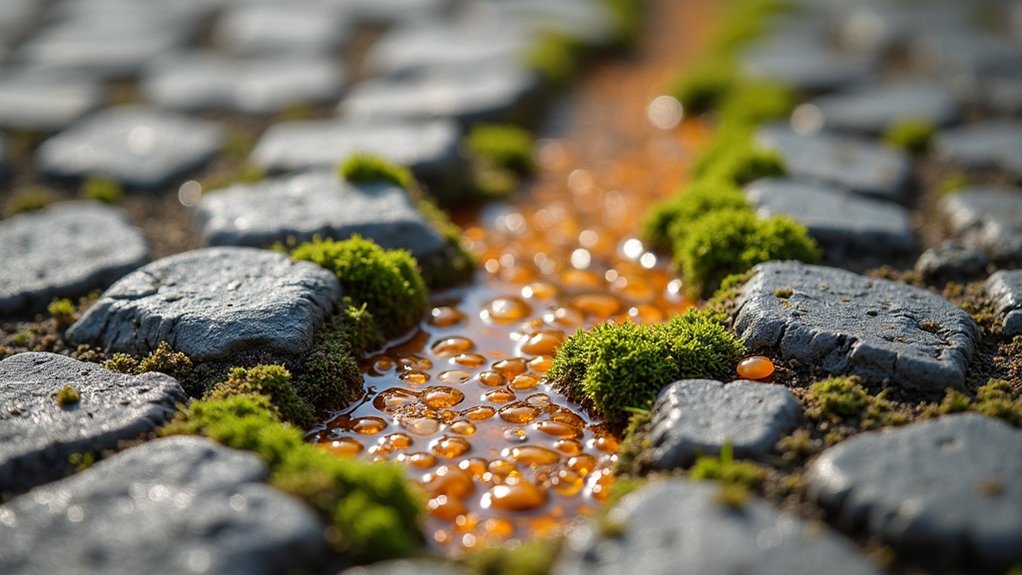Signs of ageing in resin-bound gravel are straightforward to spot. Look for cracks, particularly after harsh winters, and any rust-coloured patches that might appear around metal drainage covers. Loose stones scattered about the surface, much like loose gravel on a driveway, indicate the resin bond is failing.
Watch for colour changes – a once-vibrant surface that’s turned dull and patchy, especially in areas that catch the most sun. If your surface feels slippery when wet, where it once offered good grip, that’s a clear warning sign. Weeds poking through, similar to those you’d spot in block paving, suggest the resin structure has weakened.
Regular checks of how water drains away are crucial – any puddles that didn’t use to form might signal deeper problems. These checks, ideally done after heavy rain, help catch issues before they worsen.
Key Takeaways
Signs of Ageing in Resin-Bound Gravel:
- Watch for surface cracks and splits, much like those you’d spot in old tarmac. These are tell-tale signs your driveway’s getting on.
- Keep an eye on colour changes, especially with lighter stones – just as garden furniture fades in the sun, UV exposure will dull your gravel over time.
- If stones feel loose underfoot or the surface seems overly smooth (like worn trainers), the resin bond’s likely wearing thin.
- Stubborn muck that won’t budge with a standard wash, rather like ingrained patio stains, suggests the surface needs proper attention.
- Pesky weeds popping through or fresh cracks appearing show weak spots in the resin, similar to how moss finds its way between paving slabs.
Physical Surface Damage Indicators
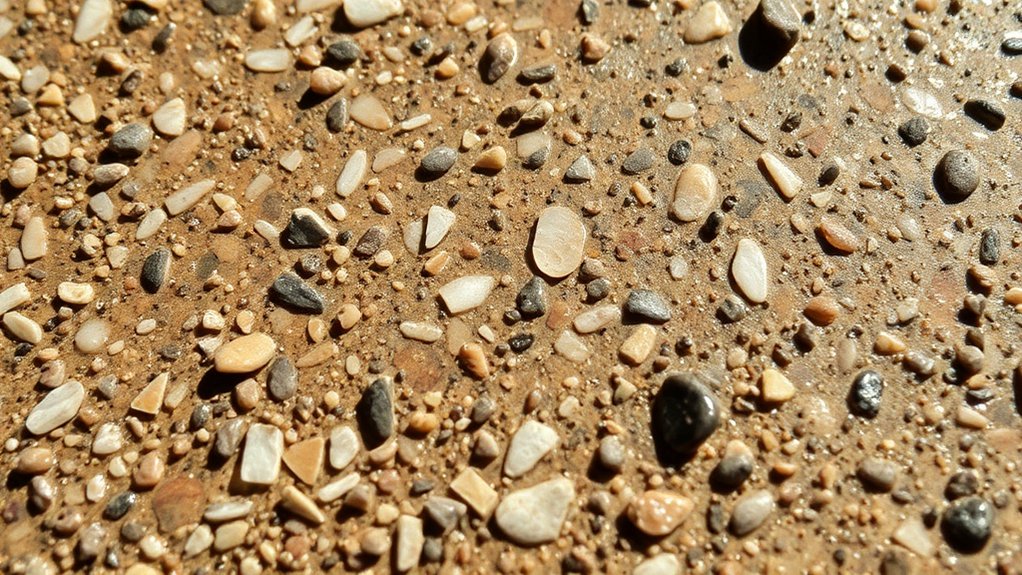
Physical damage on resin-bound gravel surfaces reveals itself through several key warning signs.
Look out for cracks, which can quickly spread if left unchecked – much like a small chip in a car windscreen. Rust spots can also appear on the surface due to oxidation of iron particles in the aggregates used, adding to the visual deterioration. Regularly inspecting for surface damage helps catch these issues early.
Surface lifting or peeling suggests problems with the underlying base, typically caused by poor initial installation or the ground settling beneath. Think of it like wallpaper bubbling away from a wall.
These issues let water seep in, especially troublesome during British winters when freeze-thaw cycles can worsen the damage.
Cracked areas become slippery when wet, posing risks similar to worn bathroom tiles.
Best practice is to check your surface monthly and sort repairs quickly – waiting too long means simple fixes can turn into major headaches.
A small crack repaired today costs far less than replacing an entire driveway next year.
Color Changes and Fading Effects
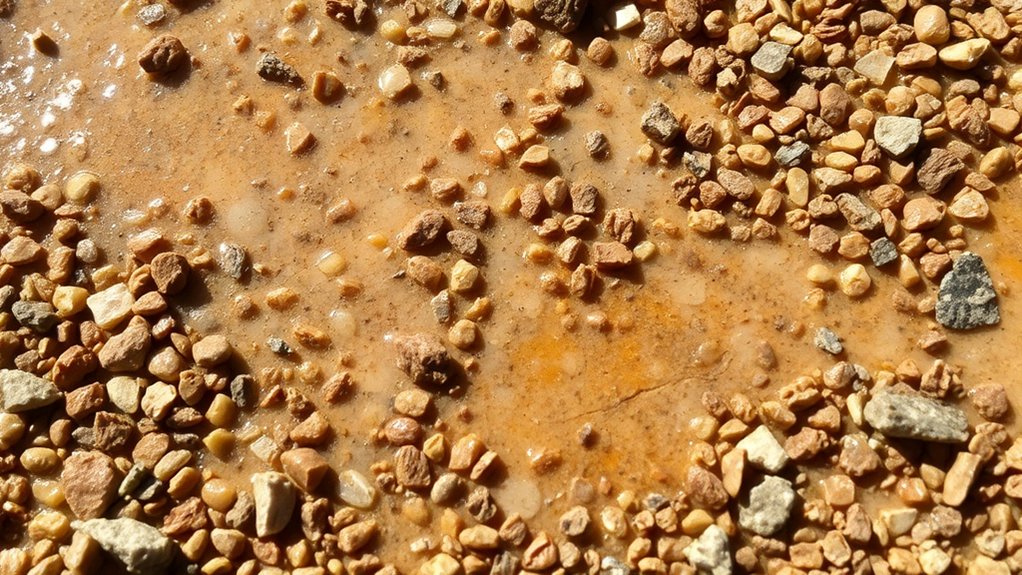
UV rays from sunlight can fade resin-bound gravel over time, particularly affecting lighter-coloured stones. Much like garden furniture left outdoors, the surface may lose its vibrancy. Daily grime and pollution also build up, causing the gravel to look dull and discoloured. Regular cleaning and choosing UV-resistant resins can help protect your driveway or path from these common issues. Applying a UV-protective sealant every few years is essential for maintaining the colour and integrity of the surface, as this will extend surface life and prevent premature fading.
UV Damage Effects
UV rays cause significant wear on resin-bound gravel driveways and paths across the UK. The sun’s rays break down the resin’s chemical structure, leading to fading – much like how garden furniture loses its colour over time. Reds and blues are particularly vulnerable to this fading, which often serves as the first sign that your surface needs checking.
Standard resins will yellow faster, especially in exposed areas with direct sunlight. UV-resistant resins, whilst pricier, offer much better protection against these effects. Think of it as the difference between leaving a plastic toy outside versus inside – the protected one maintains its appearance far longer. This is because UV-stable resins prevent breakdown and discolouration, ensuring the longevity of your surface. Additionally, using BBA-approved resins can enhance durability and weather resistance, providing extra assurance for your driveway.
To protect your investment, regular cleaning and resealing are essential. These simple maintenance steps help guard against UV damage and keep your surface looking fresh for years to come.
Environmental Pollutant Impact
Environmental pollutants significantly affect resin-bound gravel surfaces alongside UV damage, causing noticeable colour changes and fading.
Common pollutant effects include:
- Airborne pollutants leaving a grimy film
- Vehicle emissions causing dark patches
- Garden soil and leaf matter creating stubborn stains
- Acid rain altering the resin’s original colour
- Street dust dulling the overall finish
Regular maintenance keeps resin-bound gravel looking fresh. A thorough pressure wash twice yearly, combined with protective sealants, helps guard against these pollutants – much like waxing a car protects its paintwork.
The investment in proper care prevents costly repairs and maintains your driveway or patio’s kerb appeal.
Surface Texture and Grip Alterations
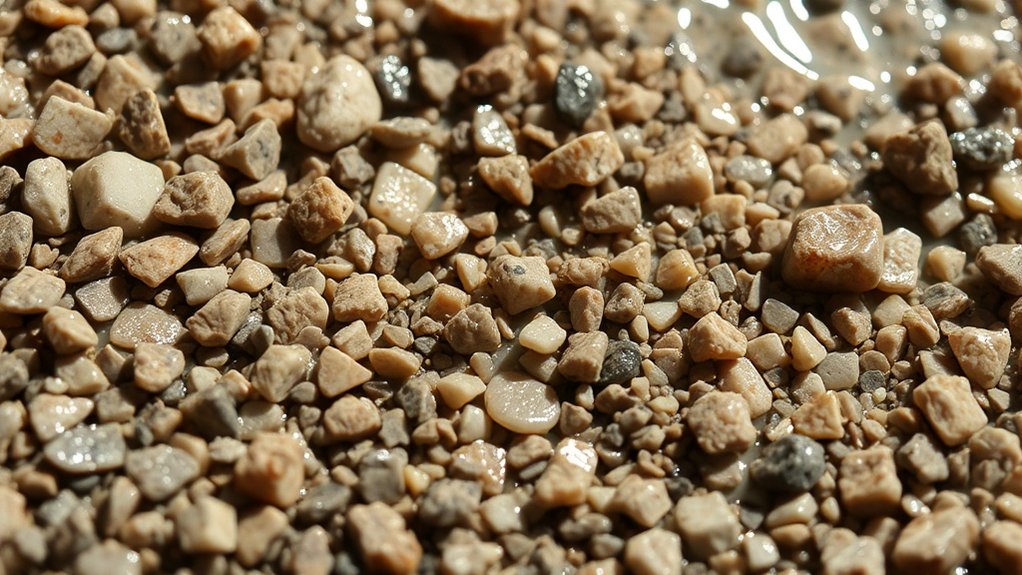
Surface texture and grip changes in resin-bound gravel are key signs of wear and tear, much like a well-worn pair of shoes losing their grip.
As the material ages from weather and regular use, you’ll notice the surface becoming smoother and less slip-resistant. This is particularly dangerous in wet conditions, rather like a polished stone patio.
Look out for tiny cracks from sun damage that weaken how well the resin holds the stones together. You might spot more loose stones on the surface – a tell-tale sign that the resin is wearing away.
A simple way to check is to look for unusually shiny patches, which often mean the surface is deteriorating.
Keep an eye out for built-up dirt and grime, as these can hide deeper problems underneath.
When you spot these changes, it’s best to sort them quickly to maintain safe, proper grip levels – especially important for driveways and paths around the home.
Weed and Vegetation Growth Signs
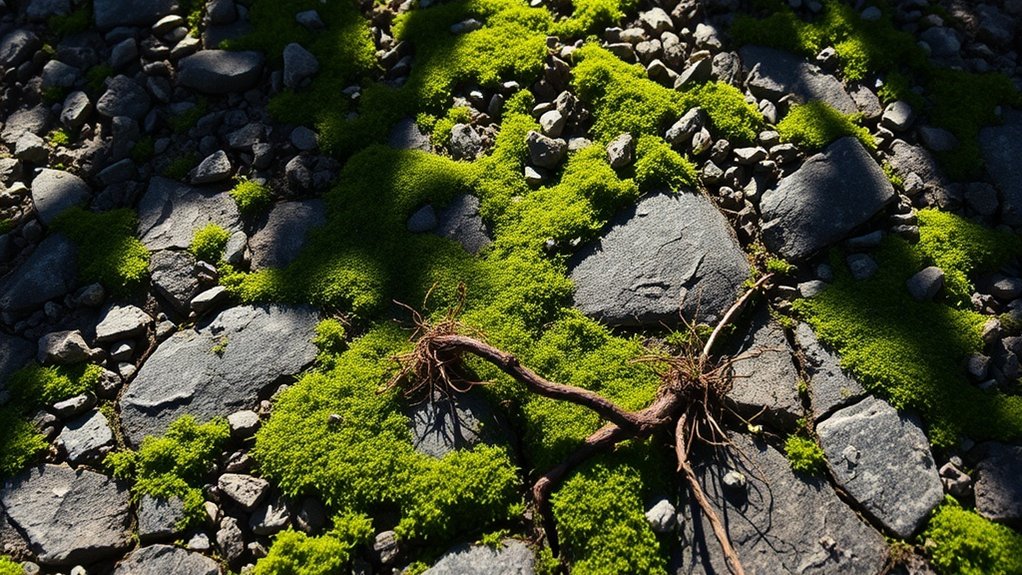
Keep an eye out for weeds sprouting through your resin-bound gravel, especially where it meets garden beds or soil.
These spots are prime trouble areas – if you spot vegetation, it could mean the resin bond is weakening due to water and dirt build-up.
Spotting and dealing with these problems early helps protect your driveway’s surface and saves hassle later on.
Early Intrusion Indicators
Signs of Unwanted Growth in Resin-Bound Driveways
Spotting early plant growth in your resin-bound surface typically signals deeper problems that need attention. Watch for these key issues:
- Fresh cracks where weeds might take root
- Weak spots along garden borders and lawn edges
- Build-up of leaves and soil that can harbour seeds
- Damp patches that encourage moss growth
- Gaps between stones that need resealing
Quick action keeps your driveway looking smart and prevents costly repairs. A monthly check and brush-down, particularly after autumn leaf fall, helps maintain the surface.
For stubborn areas, your local driveway specialist can advise on appropriate treatments.
Bonding Failure Signals
Weeds Breaking Through Resin Surfaces
Weeds pushing through your resin-bound driveway or path typically point to bonding problems or issues with the base layers. Much like cracks in concrete, these unwanted plants reveal weak spots in the surface, especially when they keep coming back. Poor weed membrane installation or tiny breaks in the resin often let roots take hold.
| Warning Sign | Why It Happens | What You Need to Do |
|---|---|---|
| Edge Weeds | Build-up of soil and leaves | Clean edges regularly |
| Seeds on Surface | Rough spots catching seeds | Brush surface weekly |
| Deep Weeds | Problems with base layer | Check foundation |
| Repeat Growth | Resin wearing away | Look into resurfacing |
Sort these problems quickly to keep your resin surface looking smart and working properly.
Structural Base and Substrate Issues
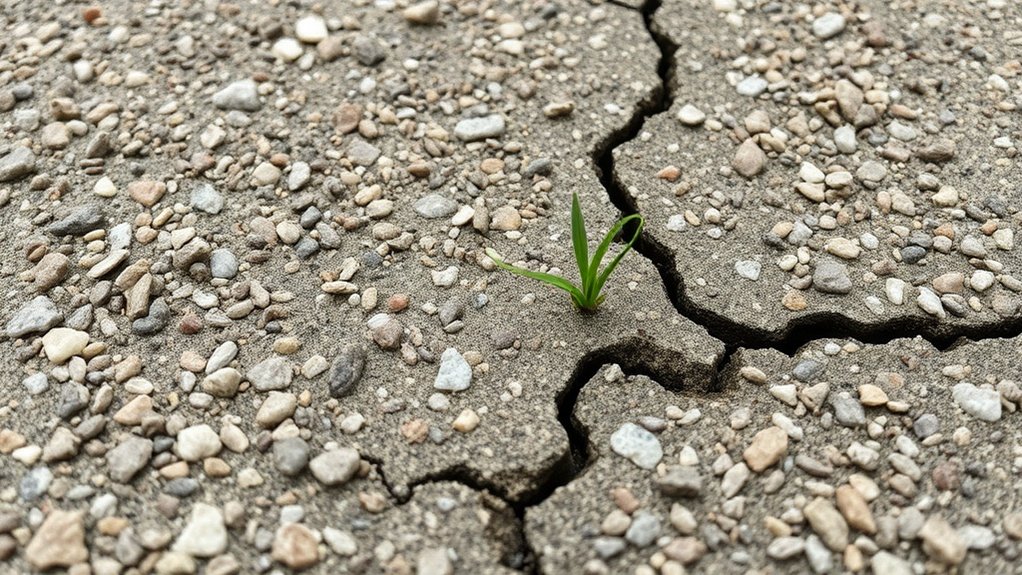
Selecting the proper structural base for resin-bound gravel proves crucial, as it directly affects durability and stability. A well-prepared base ensures the surface remains sound whilst preventing costly repairs down the line.
Key considerations for your base:
- Load-bearing requirements – think about whether it’s for a garden path or a busy car park
- Base layer compatibility – certain materials like Type 3 MOT work brilliantly for enhanced grip
- Usage and weather factors – British weather demands proper drainage to prevent water pooling
- Early warning signs – watch for cracks or dips that suggest underlying problems
- Drainage solutions – incorporate suitable gradients and permeable layers
Much like building a house, a solid foundation makes all the difference.
Poor base preparation often leads to surface failure, particularly during freeze-thaw cycles common in UK winters.
Maintenance and Aging Impact Indicators
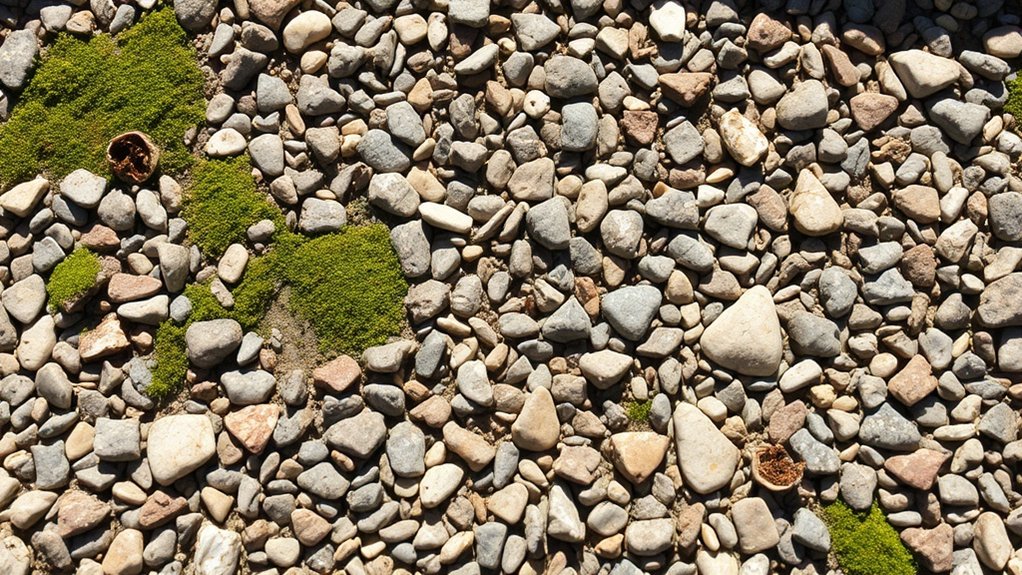
Keep an eye on these key signs as your resin-bound gravel surface ages:
Regular Maintenance Signs:
- More frequent pressure washing needs
- Stubborn dirt build-up
- Persistent stains or discolouration
Surface Damage Indicators:
- Cracks or splits in the surface
- Loose stones becoming dislodged
- Rough patches developing
Weather and seasonal factors like fallen leaves, ice damage and heavy rain can worsen these issues.
If normal cleaning with mild soap doesn’t shift stains, or if you notice any structural problems, it’s time to call in a professional.
Quick action on these warning signs helps extend your surface’s lifespan and keeps repair costs down.
Regular checks, especially after harsh weather, will help spot problems early.
Impact of UV Radiation on Resin Surfaces
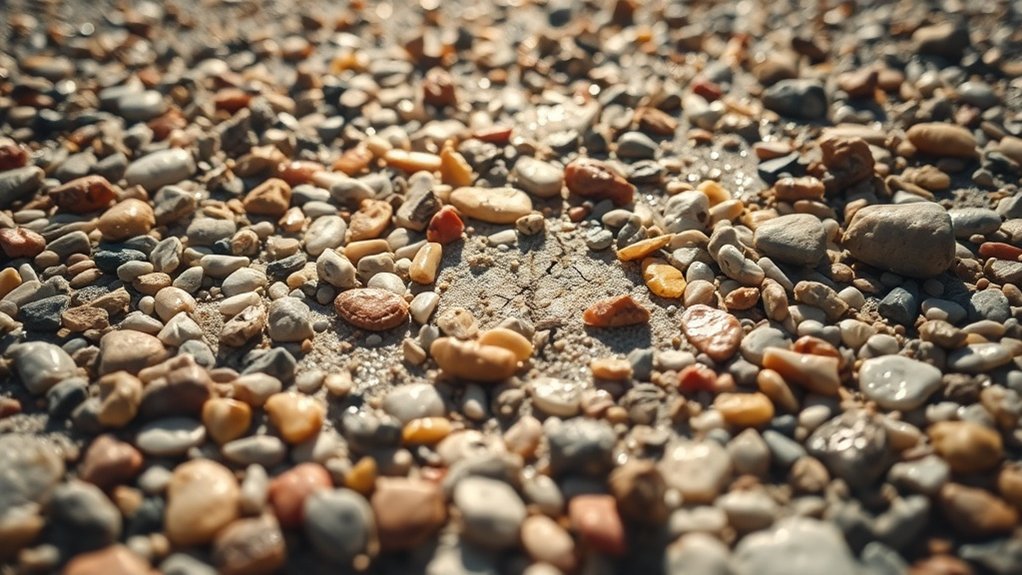
UV radiation poses significant risks to resin surfaces, causing noticeable colour fading and compromising their appearance.
Much like how the sun bleaches garden furniture over time, UV exposure can weaken the resin’s structure, leading to surface breakdown.
For resin-bound driveways and paths, UV stability proves crucial – think of it as sunscreen for your outdoor surfaces.
Without proper UV protection, these installations may require costly repairs or replacement far sooner than expected.
Color Fading Effects
UV Light’s Effect on Resin-Bound Gravel Colour
UV radiation significantly affects resin-bound gravel surfaces, causing noticeable colour fading and yellowing over time – much like how garden furniture fades in direct sunlight.
Light colours, particularly cream and beige, show these changes most dramatically.
Key points for colour preservation:
- Choose resins with UV stabilisers
- Invest in premium-grade resins for better sun resistance
- Clean and seal surfaces regularly
- Watch for uneven fading, especially in partly shaded areas
- Keep surfaces free from pollutants like car exhaust residue
Think of UV protection for resin surfaces as sunscreen for your driveway – it’s essential for maintaining appearance, particularly in exposed areas.
Most UK installations benefit from proper UV-resistant materials, even in our often cloudy climate.
Smart material choice and routine care keep your resin-bound surface looking fresh for years.
For best results, work with suppliers offering UV-stable products tested for British weather conditions.
Surface Degradation Risks
UV damage to resin-bound gravel goes well beyond simple colour fading. Much like how the sun fades garden furniture, UV rays break down the resin that holds your gravel together, causing serious surface problems.
Over time, you’ll notice the surface becoming chalky and developing small cracks – rather like an old plastic garden chair left out too long in the sun.
Different types of resin react differently to UV exposure, but most will eventually show signs of wear. When the resin weakens, your driveway or path becomes more vulnerable to everyday wear and tear, much like a weakened elastic band that’s lost its stretch.
Keep an eye out for:
- Chalky, dull patches
- Surface cracks
- Loose stones
- Crumbling edges
Regular checks help spot these issues early, saving you from costly repairs down the line. If you notice any of these signs, it’s worth getting them sorted quickly to keep your surface in good nick.
UV Stability Importance
UV Stability: What You Need to Know
UV stability makes all the difference to resin-bound surfaces, even if you can’t spot the effects straight away.
Sunlight takes its toll on these surfaces much like it does on garden furniture or car paint.
Consider these key points:
- Quality resins contain UV absorbers and stabilisers for added protection
- UV-stable surfaces keep their original colour rather than turning yellow or fading
- Without proper UV protection, surfaces can crack and deteriorate
- UV-stable resins last notably longer than standard alternatives
- Choosing UV-stable products from the start saves hassle and money later
The difference shows particularly in British weather, where surfaces face both intense summer sun and harsh winter conditions.
Much like suncream protects your skin, UV stability protects your resin surface.
Effects of Environmental Pollutants
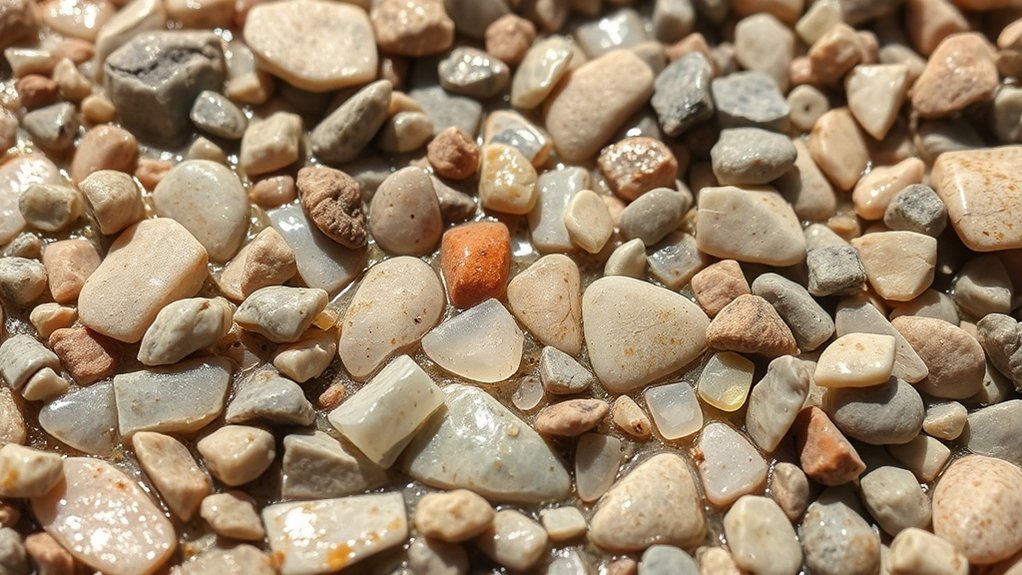
Environmental pollutants pose serious risks to resin-bound gravel surfaces across the UK. When pollutants settle on these surfaces, they trigger harmful chemical reactions that speed up wear and tear. Common culprits include car fumes, factory emissions and acid rain, which react badly with the resin and stones, causing unsightly discolouration and breakdown of materials.
The biggest threats come from nitrogen oxides and sulphur dioxide found in urban air pollution – these chemicals stain the resin, whilst oil drips from vehicles seep into the surface and weaken the binding.
Just like paint fading in sunlight, UV rays work with these pollutants to make the surface brittle and prone to cracking. Meanwhile, tiny particles of dirt act like sandpaper, gradually wearing away the top layer.
These effects don’t just spoil the look of your driveway or patio – they significantly shorten how long your resin-bound gravel will last. Understanding these risks is crucial for maintaining these surfaces, particularly in built-up areas where pollution levels tend to be higher.
Importance of Regular Inspections
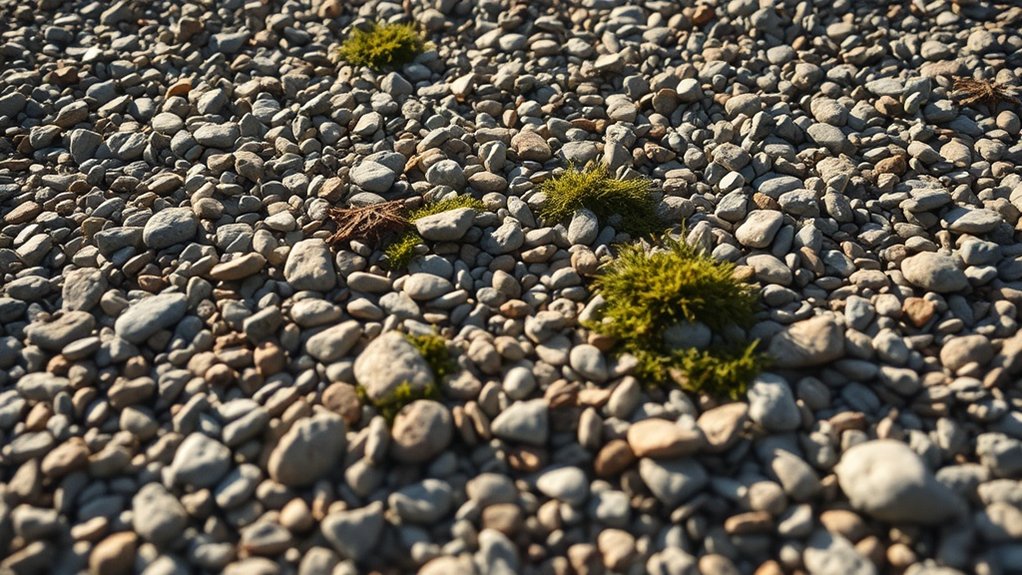
Regular checks of resin-bound gravel surfaces are vital to maintain their quality and extend their life. A proper inspection routine helps spot early warning signs and avoid expensive repairs.
Key inspection points:
- Watch for surface cracks and crazing that might let water seep in
- Spot colour changes and loose stones that show sun damage
- Check for puddles, which hint at poor drainage
- Keep a log to plan maintenance and spot patterns
- Check busy areas more often, like driveways or shop entrances
A monthly walk-around should suffice for most surfaces, though commercial spaces might need weekly checks.
If you notice any issues, it’s best to sort them straight away – much like treating a small chip in your car windscreen before it spreads.
Preventative Measures for Longevity
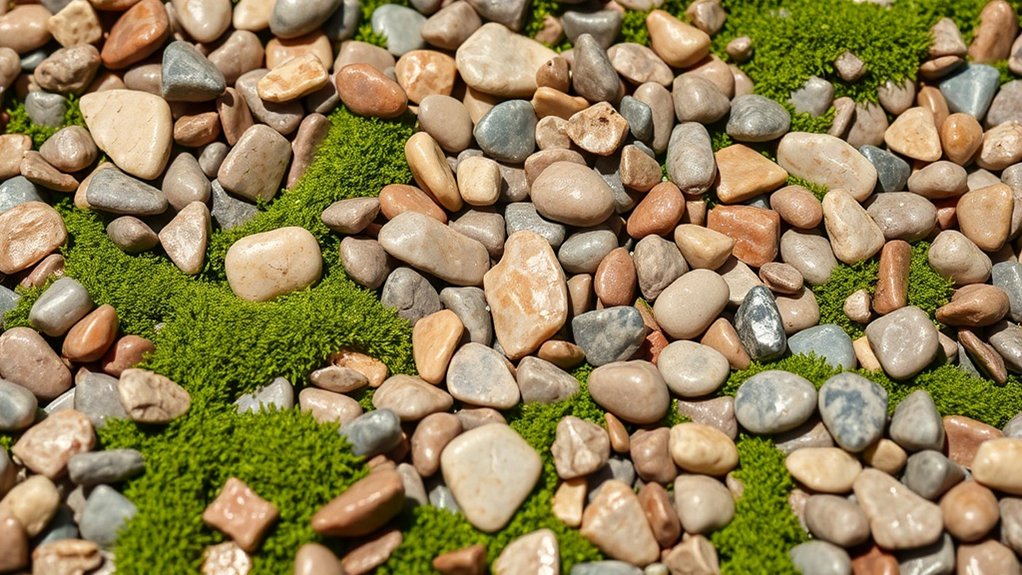
Essential preventative measures ensure your resin-bound gravel surface lasts longer and maintains its quality.
Choose UV-stable resins and weather-resistant aggregates to protect against British weather and sunlight damage.
Regular maintenance is crucial – sweep monthly and wash gently to stop moss growth, which is common in the UK climate.
Sort out stains straight away with gentle cleaning products, much like you’d with your patio.
Apply a UV-protective sealant every 5-8 years, and fix any small cracks as soon as you spot them.
Ensure proper drainage with a slight gradient – particularly important given our wet weather.
These simple steps will significantly extend your surface’s lifespan and keep it looking smart.
Frequently Asked Questions
How Often Should Resin-Bound Gravel Be Cleaned?
Resin-bound gravel needs a regular wash-down with a garden hose to shift loose dirt and debris. A monthly pressure wash at low setting keeps the surface looking fresh. For stubborn stains or algae growth, particularly common in shaded areas, tackle with a specialised resin cleaner every three to four months. Regular upkeep prevents long-term issues and maintains the surface’s grip and appearance.
Can I Repair Small Cracks Myself?
Small cracks can be repaired as a DIY job. First, examine the crack’s width and depth. For hairline cracks, use a concrete filler or epoxy resin from your local DIY shop. For slightly larger cracks up to 5mm, opt for a specialised repair mortar. Always clean the area thoroughly with a wire brush and remove loose debris before applying any filler. Apply the repair material according to the manufacturer’s instructions, typically working it deep into the crack. Allow proper drying time – usually 24 hours – before painting or sealing.
What Products Are Safe for Cleaning Resin Surfaces?
Cleaning resin surfaces requires gentle care. Eco-friendly products like POLYCLEANER and mild washing-up liquid work best. Regular cleaning helps maintain the surface, whilst harsh abrasives will damage the finish. For best results, stick to non-scratching cleaners and soft cloths.
How Does Weather Affect Resin-Bound Gravel Lifespan?
Weather plays a crucial role in how long resin-bound gravel lasts. The British climate, with its frequent rain and temperature swings, can take its toll on these surfaces. Much like how frost damages garden paths, extreme weather can cause the resin to crack or wear down over time. UV rays from summer sun, heavy rainfall, and winter freezes all affect the surface’s strength. Regular upkeep, such as cleaning and checking for damage after harsh weather, helps maintain the surface’s quality and extends its lifespan.
When Should I Consider Replacing My Resin Surface?
Consider replacing your resin surface when clear signs of deterioration appear, much like an old carpet showing its age. If regular maintenance no longer keeps the surface intact, or you notice structural cracks and poor drainage, it’s time for a replacement. Watch for widespread colour fading, significant surface damage or areas where water pools after rain.
Conclusion
Regular checks of resin-bound gravel surfaces are vital to spot wear and tear early on. Watch for key signs like cracks, fading colours and unwanted plant growth between the stones. Much like checking your car’s tyres, routine inspections help catch small issues before they become costly problems. UV rays from British weather and everyday dirt can take their toll, so staying on top of maintenance ensures your driveway or path remains smart-looking and practical. Swift action on these signs helps preserve both the surface’s appearance and function.
